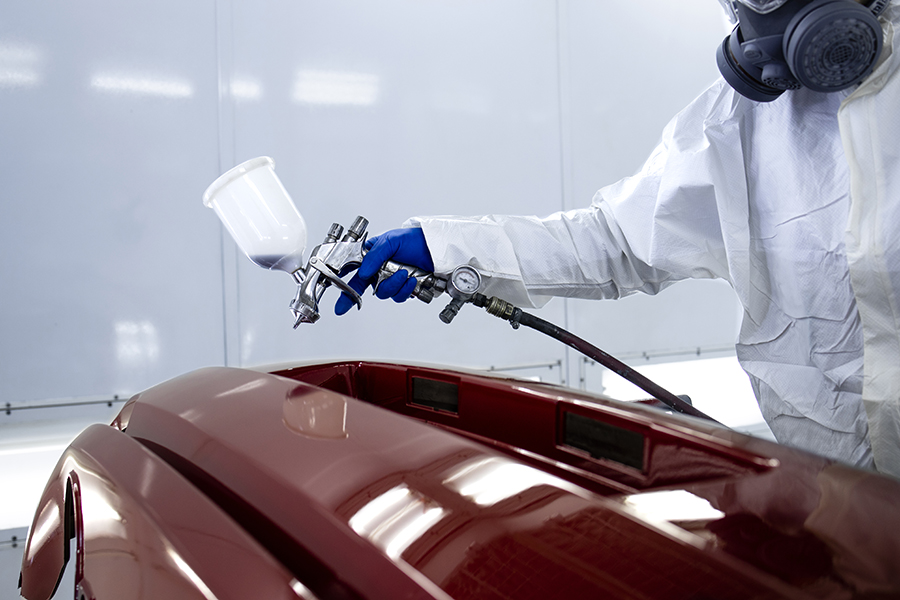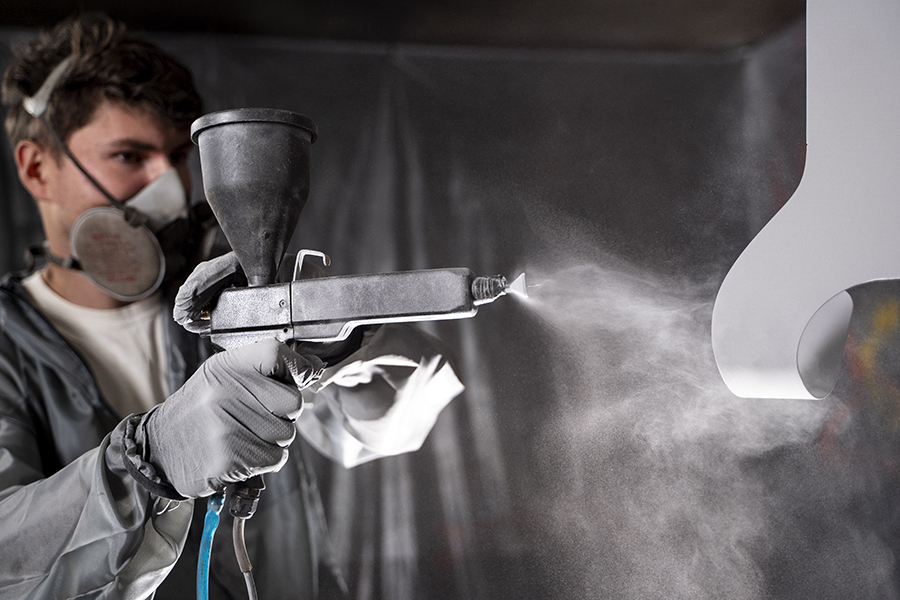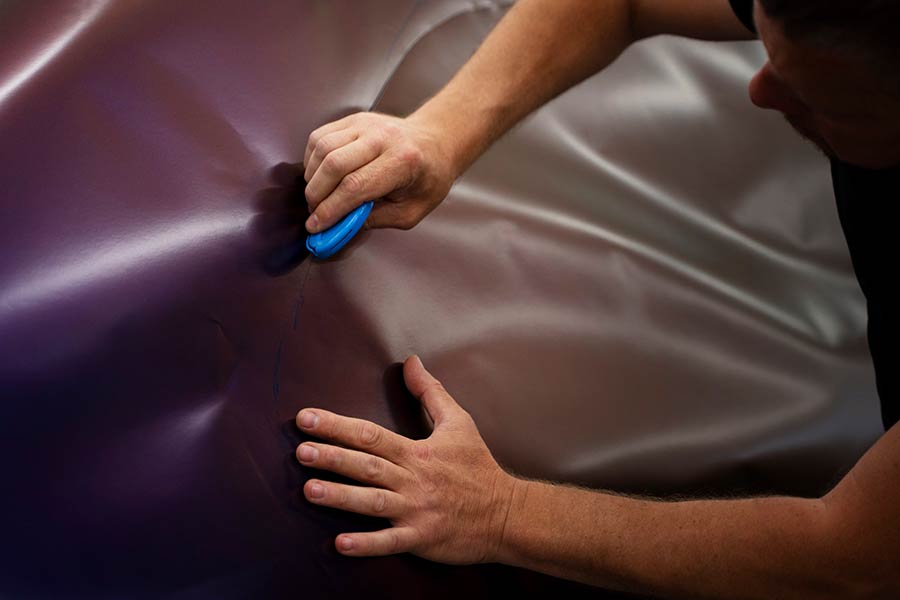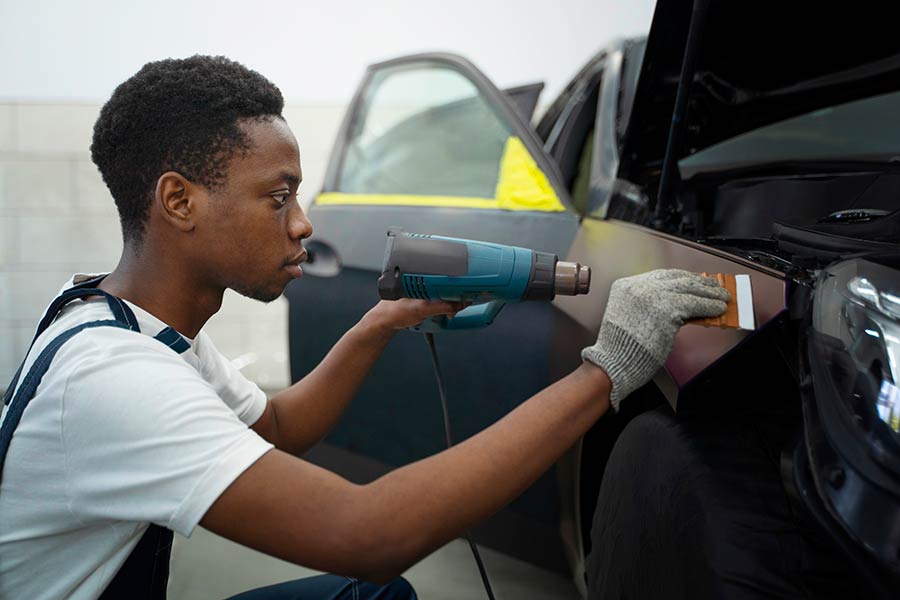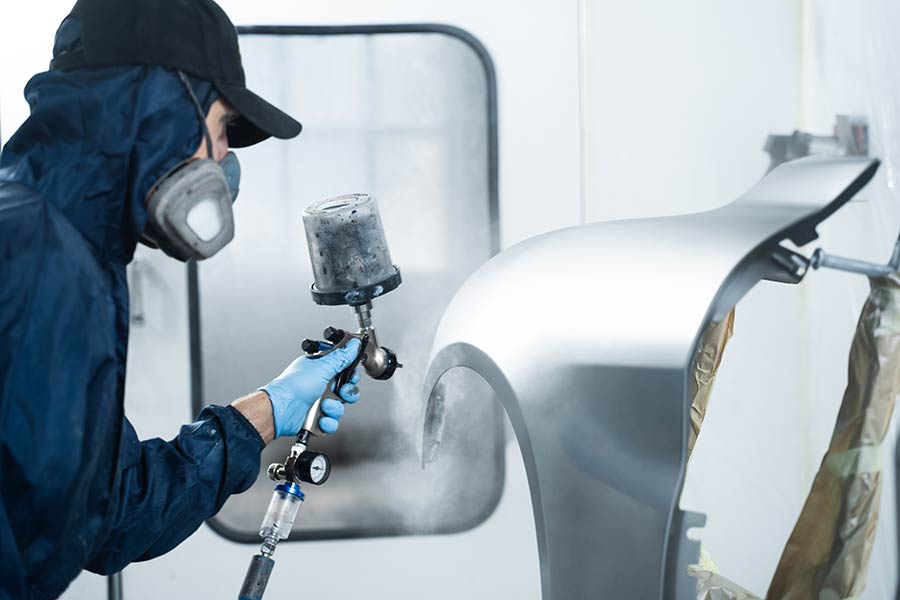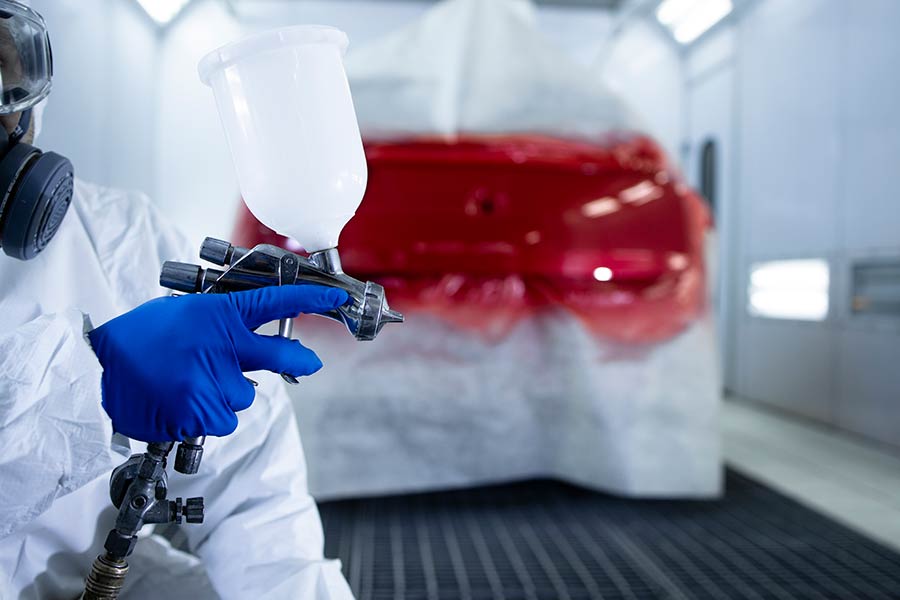Did you know that the average car gets 3-5 paint chips or scratches every year?
That small shopping cart ding, those mysterious scratches from the parking lot, or that bird dropping that sat too long - they all add up. Your car’s paint job isn’t just about looks - it’s your vehicle’s first line of defense against rust and deterioration.
The good news? Most paint damage is fixable, whether you’re dealing with tiny chips or need a complete repaint. Paint repair on cars has come a long way, with advanced color-matching technology and repair techniques that can make damage disappear like it never happened.
From quick DIY fixes to professional body shop work, we’ll show you every option available for bringing back your car’s showroom shine. Let’s look at how to fix your car’s paint problems, what it might cost, and when to tackle it yourself versus calling in the pros.
Types of Car Paint Damage
When I inspect cars for paint damage, I see three distinct categories that every car owner should know about. Let’s break down these paint problems so you can spot them early and take action.
Surface Level Paint Issues
Surface level damage is what I see most often in my work. These issues include light scratches, swirl marks, and minor chips that haven’t penetrated beyond the clear coat. The telltale signs are rough spots you can feel when running your hand across the paint, or spider web-like patterns visible under direct sunlight. While these problems might look scary, they’re usually the easiest to fix.
Deep Paint Problems
The most serious issues I deal with go beyond the surface. Here’s what makes deep paint problems different:
| Damage Type | Identification | Severity |
|---|---|---|
| Clear coat failure | Cloudy, peeling areas | High |
| Deep scratches | Catch your fingernail | High |
| Paint etching | Permanent indentations | Medium |
These problems often start small but grow worse over time. When I see clear coat peeling or deep scratches reaching the metal, I know immediate action is needed to prevent rust and further deterioration.
Environmental Paint Damage
The environment can be brutal on your car’s paint. Here are the main culprits I encounter:
- UV rays cause fading and oxidation, especially on darker colors
- Bird droppings contain acids that eat through paint layers
- Tree sap bonds to the surface and can pull off paint when removed
- Industrial fallout creates tiny metal particles that embed in the paint
- Salt air near coastal areas speeds up paint deterioration
I’ve seen perfectly good paint jobs ruined by these environmental factors. The good news? Most paint damage can be fixed with the right approach, whether it’s a simple polish for surface issues or a complete paint repair on cars with deeper problems.
Professional Paint Repair Methods
As a professional auto painter with 15 years of experience, I’ve watched paint repair technology transform dramatically. Let me walk you through the most advanced methods we use today for perfect results.
Body Shop Techniques
In my body shop, we follow a precise multi-stage process. First, we prep the surface meticulously - this isn’t just cleaning, it’s creating the perfect foundation. We use a combination of water-based and solvent-based paints:
| Paint Type | Benefits | Best For |
|---|---|---|
| Water-based | Eco-friendly, Low VOCs | Large areas |
| Solvent-based | Quick-drying, Durable | Spot repairs |
The secret to flawless results? Multiple thin layers rather than one thick coat. I always apply 2-3 base coats, followed by a protective clear coat.
Mobile Paint Services
Mobile paint services have revolutionized how I approach repairs. Here’s what makes them special:
- Repairs completed in about 2 hours
- Same high-quality paints as body shops
- Significantly lower costs than traditional shops
- Convenience of at-home service
I’ve found that mobile services work perfectly for minor to medium damage, saving my clients both time and money.
Paint Matching Technology
The most impressive advancement I’ve seen is in paint matching technology. We now use spectrophotometers and digital color analysis to achieve perfect matches. This system captures exact color data from your car’s surface, analyzing even the subtlest variations in hue and metallic content.
What amazes my clients most is how this technology accounts for paint aging and fading. When I repair a five-year-old red car, I don’t match it to the factory color - I match it to how that red looks today. The computer adjusts the formula to create an exact match for your current paint condition.
The results speak for themselves - repairs that blend so perfectly, even I sometimes can’t spot them after a few days. This digital precision has transformed paint repair on cars from an art form into a science, though I still maintain that the human touch in application makes all the difference.
DIY Paint Repair Steps
I’ve helped countless car owners fix their paint damage at home, and I’m going to show you exactly how to do it right. With proper tools and technique, you can achieve professional-looking results.
Required Tools and Materials
Here’s what you’ll need for a successful paint repair:
| Basic Tools | Safety Equipment | Paint Materials |
|---|---|---|
| Sandpaper (220-3000 grit) | Face mask | Color-matched paint |
| Microfiber cloths | Safety goggles | Primer |
| Clay bar | Gloves | Clear coat |
| Denatured alcohol | Ventilation fan | Polishing compound |
Surface Preparation Process
The success of your paint repair depends on proper preparation. Here are my proven steps:
- Clean the damaged area with car soap and water
- Remove contaminants with clay bar
- Sand the area with 220-grit paper
- Clean with denatured alcohol
- Mask surrounding areas with tape
Important: Never skip the cleaning steps - dirt trapped under paint will ruin your repair.
Paint Application Methods
I always start with a thin primer layer. The key is patience - multiple thin coats work better than one thick layer. Apply primer in steady, straight lines, keeping the spray can 6-8 inches from the surface.
For the color coat, I follow these techniques: * Light, even strokes for consistent coverage * 15-minute drying time between coats * Two to three thin layers for perfect color match
After the color dries, apply clear coat using the same careful technique. Remember: The clear coat needs 48 hours to fully harden before you polish the area.
Safety First: Work in a well-ventilated area and always wear proper protection. Paint fumes can be dangerous in enclosed spaces.
Paint Touch-Up Techniques
Let me share my most advanced paint touch-up methods that I’ve perfected over years of working on luxury vehicles. These techniques will help you achieve results that look like they came from a professional shop.
Chip and Scratch Filling
The secret to perfect paint repair on cars starts with proper filling. I always begin with a fast-drying putty for deep scratches and chips. Here’s my professional method: spread the putty with a plastic spreader, keeping it slightly higher than the surrounding area. After it dries, I wet-sand with 600-grit paper until it’s perfectly level with the surface.
Clear Coat Application
Clear coat makes or breaks your repair job. I follow this tested process:
| Step | Technique | Drying Time |
|---|---|---|
| First layer | Light mist coat | 10 minutes |
| Second layer | Medium wet coat | 15 minutes |
| Final layer | Full wet coat | 48 hours |
Pro tip: I keep the spray can 6-8 inches from the surface and move in straight, steady lines.
Blending and Finishing
Blending is where amateur repairs stand out from professional work. My foolproof blending approach includes:
- Starting from the repair’s edge, gradually reducing paint application outward
- Using a special blending solvent while the clear coat is still wet
- Wet sanding with 2000-grit paper in a 2-foot radius around the repair
The real magic happens in the final stage. I wet sand the entire blended area with 3000-grit paper, then polish with a cutting compound. This creates what I call the “invisible transition” - where your eye can’t spot where the repair begins or ends.
Remember: The temperature matters more than you think. I always work between 65-75°F for the best results. Too hot, and your clear coat dries too fast; too cold, and it won’t flow properly.
For metallic paints, I add an extra step: spraying the base coat in a lighter, dusted pattern at the edges. This helps the metallic flakes align perfectly with the existing paint, making the repair truly invisible.
Cost Analysis of Paint Repairs
Looking at my pricing records from thousands of paint repair jobs, I want to share what you can really expect to pay. Let’s break down the actual costs that matter to you.
Price Ranges by Damage Type
After working on countless vehicles, I’ve compiled this detailed pricing guide:
| Damage Type | Average Cost Range |
|---|---|
| Small chips/scratches | $900 - $1,500 |
| Panel repainting | $1,170 - $1,770 |
| Bumper repair | $1,290 - $1,890 |
| Door repainting | $840 - $1,440 |
| Full car respray | $2,020 - $5,000 |
Remember: The size of your vehicle and paint quality will affect these prices. I’ve seen basic paint jobs start at $500, while premium work can reach $10,000 or more.
DIY vs Professional Costs
When comparing DIY and professional paint repair on cars, the numbers tell an interesting story. A DIY job typically costs between $200-$600 for materials alone. Here’s what I tell my clients about cost differences:
- Professional work includes prep, paint, and warranty
- DIY requires buying tools you might only use once
- Professional color matching prevents costly mistakes
- Quality materials cost more but last longer
Insurance Coverage Options
I’ve guided many clients through insurance claims for paint damage. Here’s what you need to know:
Your insurance can help in two ways: 1. Collision coverage pays for accident-related paint damage 2. Comprehensive coverage handles non-accident damage like vandalism
The catch? Your deductible matters. If it’s $500 and the repair costs $1,000, you’ll pay the first $500. I always tell my clients: for minor scratches costing less than your deductible, paying out of pocket makes more sense.
Pro tip: If another driver damages your paint, their insurance should cover the full repair cost - no deductible needed.
Conclusion
Paint damage happens to every car, but now you know exactly how to handle it - whether through professional work or DIY repairs. My years of experience show that quick action on paint problems saves money and prevents bigger issues down the road.
Professional paint repair offers precision color matching and guaranteed results. When you need expert help, Schedule Repair with a qualified shop that uses modern paint matching technology and proven repair techniques.
DIY repairs work well for minor damage if you follow the right steps and use quality materials. Remember that proper preparation and patience during application make the difference between an obvious patch and a seamless fix.
Most importantly, consider your specific situation - the damage severity, repair costs, and your skill level - when choosing between professional and DIY options. Regular maintenance and prompt repairs will keep your car looking great and protected from rust for years to come.
## FAQs
-
How much does it typically cost to repair paint damage on a car? The cost of paint repair varies depending on the type and extent of damage. Small chips and scratches can cost between $900 to $1,500, while a full car respray can range from $2,020 to $5,000 or more. Panel repainting averages $1,170 to $1,770, and bumper repairs typically cost $1,290 to $1,890. Keep in mind that factors like vehicle size and paint quality can affect these prices.
-
Can I repair car paint damage myself? Yes, you can repair minor paint damage yourself. DIY repairs typically cost between $200-$600 for materials. However, it’s important to note that professional work includes preparation, paint application, and often comes with a warranty. DIY repairs require proper tools, techniques, and patience. For best results, follow a careful process of surface preparation, priming, color matching, and clear coat application.
-
How long does it take for car paint repairs to dry? Drying times vary depending on the type of repair and paint used. For DIY repairs, primer and color coats usually need about 15 minutes between applications. However, the clear coat needs at least 48 hours to fully harden before polishing. Professional repairs might have different drying times based on the products and techniques used.
-
What causes car paint damage? Car paint damage can be caused by various factors. Surface-level issues often result from light scratches, swirl marks, and minor chips. Deeper problems can include clear coat failure, deep scratches, and paint etching. Environmental factors like UV rays, bird droppings, tree sap, industrial fallout, and salt air can also cause significant paint damage over time.
-
How can I prevent paint damage on my car? To prevent paint damage, regularly wash and wax your car to protect it from environmental contaminants. Park in covered areas when possible to avoid UV damage and bird droppings. Address any chips or scratches promptly to prevent rust. Consider applying a paint protection film or ceramic coating for additional defense against environmental damage.
-
Does car insurance cover paint repairs? Car insurance can cover paint repairs in certain situations. Collision coverage typically pays for accident-related paint damage, while comprehensive coverage handles non-accident damage like vandalism. However, you’ll need to consider your deductible. If the repair cost is less than your deductible, it might be more cost-effective to pay out of pocket. When another driver is at fault, their insurance should cover the full repair cost without you paying a deductible.
-
What’s the difference between water-based and solvent-based car paints? Water-based paints are more eco-friendly and have lower VOCs (Volatile Organic Compounds), making them ideal for large area repairs. Solvent-based paints dry more quickly and are generally more durable, making them better suited for spot repairs. Professional body shops often use a combination of both types depending on the specific repair needs.
-
How do professionals match car paint colors? Professional auto painters use advanced technology like spectrophotometers and digital color analysis to achieve perfect paint matches. These systems capture exact color data from your car’s surface, analyzing even subtle variations in hue and metallic content. This technology can even account for paint aging and fading, ensuring that repairs blend seamlessly with the existing paint.
